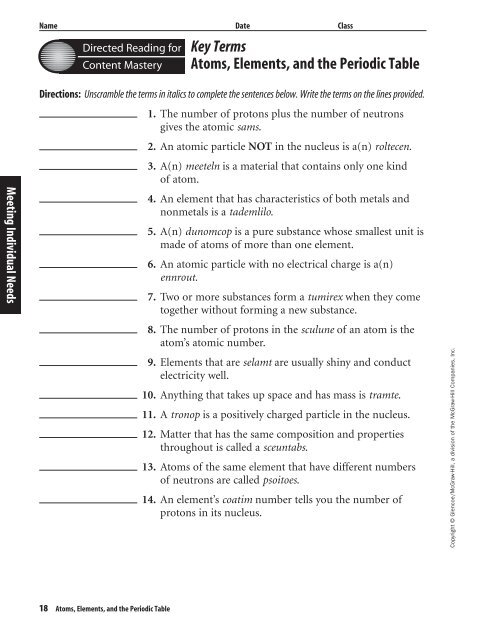Atoms, Elements, and the Periodic Table - Learning Services Home
Atoms, Elements, and the Periodic Table - Learning Services Home Atoms, Elements, and the Periodic Table - Learning Services Home
Name Date ClassDirected Reading forContent MasteryKey TermsAtoms, Elements, and the Periodic TableDirections: Unscramble the terms in italics to complete the sentences below. Write the terms on the lines provided.1. The number of protons plus the number of neutronsgives the atomic sams.2. An atomic particle NOT in the nucleus is a(n) roltecen.3. A(n) meeteln is a material that contains only one kindof atom.Meeting Individual Needs4. An element that has characteristics of both metals andnonmetals is a tademlilo.5. A(n) dunomcop is a pure substance whose smallest unit ismade of atoms of more than one element.6. An atomic particle with no electrical charge is a(n)ennrout.7. Two or more substances form a tumirex when they cometogether without forming a new substance.8. The number of protons in the sculune of an atom is theatom’s atomic number.9. Elements that are selamt are usually shiny and conductelectricity well.10. Anything that takes up space and has mass is tramte.11. A tronop is a positively charged particle in the nucleus.12. Matter that has the same composition and propertiesthroughout is called a sceuntabs.13. Atoms of the same element that have different numbersof neutrons are called psoitoes.14. An element’s coatim number tells you the number ofprotons in its nucleus.Copyright © Glencoe/McGraw-Hill, a division of the McGraw-Hill Companies, Inc.18 Atoms, Elements, and the Periodic Table
Nombre Fecha ClaseLectura dirigida paraDominio del contenidoSinopsisLos átomos, elementos y laTabla periódicaInstrucciones: Completa el mapa de conceptos usando los siguientes términos.razones específicas elementos mezclas átomosLa materiaCopyright © Glencoe/McGraw-Hill, a division of the McGraw-Hill Companies, Inc.razones quecambianpara formar3.que secombinanenestá compuesta deInstrucciones: Utiliza la información del mapa conceptual y responde las siguientes preguntas.5. Todos los elementos que forma la materia están compuestos de ____________.6. Todos los compuestos están formados de ____________________.7. Las mezclas pueden estar formadas de elementos en ____________________.8. Los compuestos contienen dos o más elementos combinados en ______________.Instrucciones: Enumera los siguientes hechos, de acuerdo a nuestro entendimiento del átomo, en el órden enque ocurrieron los hechos.9. J.J. Thomson descubre la existencia del electrón.1.que están compuestos de4.que secombinanen 2.para formarcompuestos10. John Dalton expuso que cada tipo de materia está formada de sólo untipo de átomo.11. Ernesto Rutherford sugiere que los electrones están esparcidos mayormenteen el espacio vacío alrededor del núcleo de un átomo.12. Democrito expone la teoría de que el universo está compuesta depequeñas partículas de materia llamadas átomos.Satisface las necesidades individualesLos átomos, elementos y la Tabla periódica 19
- Page 1 and 2: Glencoe ScienceChapter ResourcesAto
- Page 3 and 4: ReproducibleStudent PagesReproducib
- Page 5 and 6: Name Date ClassInvestigating the Un
- Page 7 and 8: Name Date ClassElements and the Per
- Page 9 and 10: Name Date ClassMystery MixtureLab P
- Page 11 and 12: Name Date Class1LaboratoryActivityM
- Page 13 and 14: Name Date ClassCopyright © Glencoe
- Page 15 and 16: Name Date ClassAtoms, Elements,and
- Page 17 and 18: Name Date ClassDirected Reading for
- Page 19: Name Date ClassDirected Reading for
- Page 23 and 24: Nombre Fecha ClaseLectura dirigida
- Page 25 and 26: Name Date Class1ReinforcementStruct
- Page 27 and 28: Name Date Class3ReinforcementCompou
- Page 29 and 30: Name Date Class2EnrichmentThe Perio
- Page 31 and 32: Name Date ClassSection 1Note-taking
- Page 33 and 34: Name Date ClassNote-taking Workshee
- Page 35 and 36: Name Date ClassChapterReviewAtoms,
- Page 37 and 38: TransparencyActivitiesTransparency
- Page 39 and 40: Name Date Class2Section Focus Some
- Page 41: Name Date Class1Teaching Transparen
Name Date ClassDirected Reading forContent MasteryKey Terms<strong>Atoms</strong>, <strong>Elements</strong>, <strong>and</strong> <strong>the</strong> <strong>Periodic</strong> <strong>Table</strong>Directions: Unscramble <strong>the</strong> terms in italics to complete <strong>the</strong> sentences below. Write <strong>the</strong> terms on <strong>the</strong> lines provided.1. The number of protons plus <strong>the</strong> number of neutronsgives <strong>the</strong> atomic sams.2. An atomic particle NOT in <strong>the</strong> nucleus is a(n) roltecen.3. A(n) meeteln is a material that contains only one kindof atom.Meeting Individual Needs4. An element that has characteristics of both metals <strong>and</strong>nonmetals is a tademlilo.5. A(n) dunomcop is a pure substance whose smallest unit ismade of atoms of more than one element.6. An atomic particle with no electrical charge is a(n)ennrout.7. Two or more substances form a tumirex when <strong>the</strong>y cometoge<strong>the</strong>r without forming a new substance.8. The number of protons in <strong>the</strong> sculune of an atom is <strong>the</strong>atom’s atomic number.9. <strong>Elements</strong> that are selamt are usually shiny <strong>and</strong> conductelectricity well.10. Anything that takes up space <strong>and</strong> has mass is tramte.11. A tronop is a positively charged particle in <strong>the</strong> nucleus.12. Matter that has <strong>the</strong> same composition <strong>and</strong> propertiesthroughout is called a sceuntabs.13. <strong>Atoms</strong> of <strong>the</strong> same element that have different numbersof neutrons are called psoitoes.14. An element’s coatim number tells you <strong>the</strong> number ofprotons in its nucleus.Copyright © Glencoe/McGraw-Hill, a division of <strong>the</strong> McGraw-Hill Companies, Inc.18 <strong>Atoms</strong>, <strong>Elements</strong>, <strong>and</strong> <strong>the</strong> <strong>Periodic</strong> <strong>Table</strong>



